Madhur Jaffrey’s chicken tikka masala
Probably created in Britain, chicken tikka masala – or CTM as it is often called – is easily the most popular Indian curry in the UK today. And yet nobody is quite clear about its origins. It is possible that a chef in Birmingham, with too many tandoor-roasted chicken pieces (“tikkas”) left over, decided to reheat them in a quick stir-fried curry sauce. However it originated, it is here to stay.
The tikkas need to marinate for six to eight hours. Serve with Indian breads or rice. I prefer chicken thighs but you may use breasts if you wish.
Serves 4–6
For the chicken tikka
boneless, skinless chicken thighs or breasts 675g, cut into 2½cm chunks
salt 1¼ tsp
lemon juice 3 tbsp
root ginger 1 tbsp, peeled, finely grated
garlic cloves 2, finely grated or crushed
ground cumin 1 tsp
paprika 1 tsp
chilli powder ½–¾ tsp
whipping cream 6 tbsp
garam masala ½ tsp
olive or sunflower oil 3 tbsp
For the masala
olive or sunflower oil 4 tbsp
onions 140g, halved and finely sliced
root ginger 1 tbsp, peeled, finely grated
garlic cloves 5–6, crushed
ground coriander 1 tbsp
turmeric ½ tsp
chilli powder ¾ tsp
paprika 2 tsp
yogurt 4 tbsp
medium tomatoes 2, peeled and very finely chopped
chicken stock 350ml
salt ¼ tsp, or to taste
garam masala ¼ tsp
corianderleaves 4 tbsp, chopped
Start by marinating the chicken tikka. Put the chicken in a non-reactive bowl and rub in the salt and lemon juice. Prod the chicken pieces lightly with the tip of a knife and rub the seasonings in again, then set aside for 20 minutes. Add the ginger, garlic, cumin, paprika, chilli powder, cream and garam masala. Mix well, cover, and refrigerate for six to eight hours (longer will not hurt).
When you’re ready to cook, make the masala: pour the 4 tablespoons of oil into a large, preferably non-stick, lidded pan and set it over a medium-high heat. When the oil is hot, put in the onions. Stir and fry until they brown, six or seven minutes. Add the ginger and garlic and continue to fry, stirring, for a minute. Add the ground coriander, turmeric, chilli powder and paprika. Stir for 10 seconds, then add a tablespoon of the yogurt. Stir and fry until it is absorbed. Add the remaining yogurt in this way, a tablespoon at a time.
Now put in the tomatoes. Fry them for three or four minutes, or until they turn pulpy. Add the stock and salt, and bring to a simmer. Cover, reduce the heat to low, and simmer gently for 15–20 minutes. The sauce should turn thick. Stir in the garam masala and coriander leaves, taste for seasoning and add more salt if you need it.
Shortly before you eat, preheat the grill to its highest setting. Thread the chicken on to two to four skewers (the flat, sword-like ones are best). Brush with the 3 tablespoons of oil and balance the skewers on the rim of a shallow baking tray, so that the meat is suspended and does not touch the tray. Place about 13 centimetres (5 inches) from the source of heat and grill for six minutes on each side, or until lightly browned, cooked through and charred in places. (Cut a large piece of chicken to the centre to check there is no trace of pink.)
When the tikkas are cooked, reheat the sauce and fold in the chicken.
Serve immediately.
From Madhur Jaffrey’s Curry Nation by Madhur Jaffrey (Ebury Press, £20). Click here to order a copy from Guardian Bookshop for £16
Clare Smyth’s wheaten bread
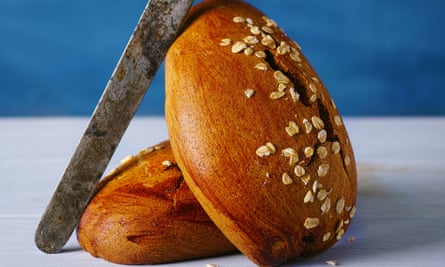
This reminds me of growing up in Northern Ireland.
Makes 2 loaves
wholemeal flour 410g
plain flour 115g
buttermilk 350g
bicarbonate of soda 7g
salt 12g
demerara sugar 25g
honey 65g
butter 60g
Combine all the dry ingredients in a mixing bowl. Melt the butter and honey over a medium heat. Pour over dry ingredients with the buttermilk and mix for 15 minutes with a dough hook on low. Divide dough into 2 and roll into even loaves. Brush with a little extra buttermilk then sprinkle with oats.
Bake at 165C/gas mark 3 in a fan forced oven for 55 minutes. Tap the base of the loaf – it must sound hollow.
Clare Smyth is chef patron at Restaurant Gordon Ramsay, London
Tom Kitchin’s Scottish grouse with bread sauce and game chips
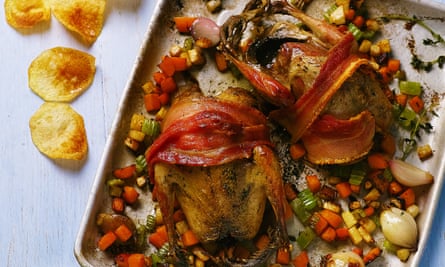
Serves 2
grouse 2, prepared and wrapped in bacon
vegetable oil
celeriac, carrots and celery 50g each, chopped into 1cm dice
baby onions 10
fresh thyme 2 sprigs
brandy 1 tbsp
salt and pepper
chicken stock 250ml
For the bread sauce
milk 250ml
large onion ½, peeled
cloves 2
butter 1 tbsp
white bread 110g, crusts removed and cut into 2cm cubes
salt and white pepper
nutmeg 1 tsp
For the game chips
large potato 1
vegetable oil 300ml
salt
Take the grouse out of the fridge so that they can come to room temperature before you start cooking. Preheat the oven to 200C/gas mark 6.
Heat a tablespoon of vegetable oil in a large heavy-bottomed roasting tin.
Season the grouse very well, inside and out, then sear them in the pan until golden brown all over. Add the diced vegetables, baby onions and thyme sprigs to the pan. Place the grouse on one breast and roast in the hot oven for 3-4 minutes. Flip the birds onto the other breast and roast for another 3 minutes. Next pour brandy into both birds and place them on their back to finish roasting – another 5 minutes.
Remove the pan from the oven and leave the grouse to rest for 10 minutes breast upwards. Keep all the pan juices and vegetables.
Put the roasting tin back on the heat on top of the stove and begin to reduce the cooking juices. Add the chicken stock, bring to the boil and let the sauce reduce and thicken. Take off the heat and pass through a fine sieve. Keep warm until ready to serve.
To make the bread sauce, simmer the milk with the onion stuck with cloves and cook until the onion is tender. Strain the milk into a clean pan and add the butter. Next, whisk in the bread off the heat and mix until smooth. For a smoother sauce, use a hand blender. Season with salt, white pepper and nutmeg.
To make the game chips, using the criss-cross part of a mandolin, cut the potato into slices roughly 3mm thick. Warm the oil gently on the stove. Dip a slice into the oil to check the oil is hot enough. Fry the potatoes until crispy. Drain on a paper towel and season lightly with salt.
Serve the grouse whole with pan juices, vegetables, bread sauce, game chips and sauteed spinach and girolles.
From Nature to Plate by Tom Kitchin (Orion, £16.99). Click here to order a copy from Guardian Bookshop for £12.99
Tomos Parry’s lobscows with laverbread
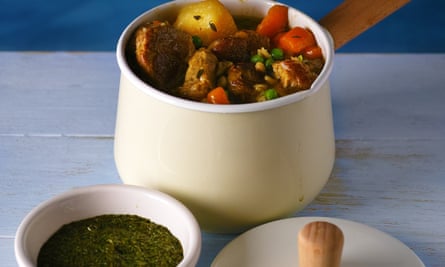
My mother used to make lobscows (a traditional North Wales stew). It always reminds me of cold October evenings in Wales.
Serves 4-5
vegetable oil 50ml
neck of Welsh mutton fillet 800g, cut into rough 2cm cubes
salt and freshly ground black pepper
leek 1, cut into 1½cm pieces
onion 1 large, peeled
carrots 3, peeled and roughly chopped
potatoes 500g, medium, peeled, quartered
peas 200g, fresh or frozen
thyme a few sprigs
chicken or lamb stock 2 litres
pearl barley 50g
laverbread 50g
parsley 25g, finely chopped
Heat the vegetable oil in a heavy-bottomed frying pan, season the meat with salt and pepper and fry until nicely coloured (chargrill if possible).
Add the rest of the ingredients except the laverbread and parsley, bring to the boil, lightly season with salt and pepper and simmer gently for 2-2½ hours until the meat is tender.
When finish, leave to rest (my mother thinks it’s actually better the next day). Spoon a teaspoon of laverbread into each portion and stir in the parsley.
Tomos Parry is head chef at Kitty Fisher’s, London; kittyfishers.com
Nigel Slater’s luxury cauliflower cheese
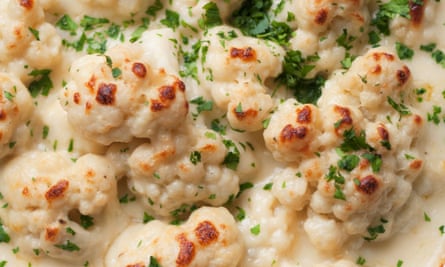
Serves 4 as a side dish, 2-3 as a main
milk 1 litre
bay leaf 1
onion 1 small
cloves 2
butter 50g
plain flour 50g
double cream 4 tbsp
strong farmhouse cheddar 100g, grated
large cauliflower 1
spenwood or parmesan 4 tbsp, finely grated
Pour the milk into a saucepan and drop in the bay leaf. Peel the onion, spike it with the cloves and add to the pan. Bring to the boil. As soon as the milk starts to rise in the pan, turn it off and leave to sit for 10 minutes, while the bay and cloves work their subtle magic. Set the oven at 220C/gas mark 7.
Melt the butter in a heavy-based saucepan, tip in the flour and let the mixture cook, stirring regularly, till it is biscuit coloured and smells warm and nutty. Pour in the warm milk (leaving behind the onion while taking the bay leaf with you) and let it come almost to the boil. Stir as it thickens, seasoning with salt and pepper, and resorting to a whisk if you need to beat out any lumps. It is less trouble than a spoon. Turn down the heat and let the sauce simmer peacefully for a good 15 to 20 minutes. Stir in the cream and the grated cheddar, then adjust the seasoning.
Break the cauliflower into large florets. Bring a pan of water to the boil, salt it lightly, then drop in the florets. Leave at a merry boil for three or four minutes, till they will take the point of a knife without too much pressure.
Drain them carefully so they don’t break up, then tip them into a baking dish. Pour over the cheese sauce, fishing the bay leaf out or not as you wish, then scatter the surface with the grated spenwood or parmesan. Bake for 20 minutes or so, till the sauce has formed a patchily golden crust and is bubbling languidly around the edge.
From Tender Volume I by Nigel Slater (Fourth Estate, £30). Click here to order a copy from Guardian Bookshop for £24
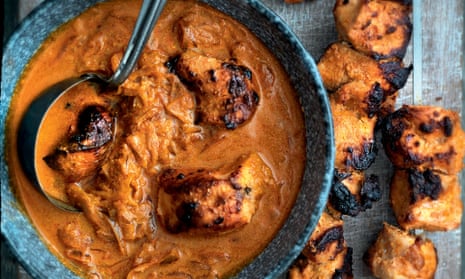
Comments (…)
Sign in or create your Guardian account to join the discussion